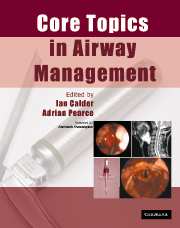Book contents
- Frontmatter
- Contents
- List of contributors
- Preface
- Acknowledgements
- List of abbreviations
- 1 Anatomy
- 2 Physiology of apnoea and hypoxia
- 3 Physics and physiology
- 4 Cleaning and disinfection of airway equipment
- 5 General principles
- 6 Maintenance of the airway during anaesthesia: supra-glottic devices
- 7 Tracheal tubes
- 8 Tracheal intubation of the adult patient
- 9 Confirmation of tracheal intubation
- 10 Extubation
- 11 Light-guided intubation: the trachlight
- 12 Fibreoptic intubation
- 13 Retrograde intubation
- 14 Endobronchial and double-lumen tubes, bronchial blockers
- 15 ‘Difficult airways’: causation and prediction
- 16 The paediatric airway
- 17 Obstructive sleep apnoea and anaesthesia
- 18 The airway in cervical trauma
- 19 The airway in cervical spine disease and surgery
- 20 The aspiration problem
- 21 The lost airway
- 22 Trauma to the airway
- 23 Airway mortality associated with anaesthesia and medico-legal aspects
- 24 ENT and maxillofacial surgery
- 25 Airway management in the ICU
- 26 The airway in obstetrics
- Index
7 - Tracheal tubes
Published online by Cambridge University Press: 15 December 2009
- Frontmatter
- Contents
- List of contributors
- Preface
- Acknowledgements
- List of abbreviations
- 1 Anatomy
- 2 Physiology of apnoea and hypoxia
- 3 Physics and physiology
- 4 Cleaning and disinfection of airway equipment
- 5 General principles
- 6 Maintenance of the airway during anaesthesia: supra-glottic devices
- 7 Tracheal tubes
- 8 Tracheal intubation of the adult patient
- 9 Confirmation of tracheal intubation
- 10 Extubation
- 11 Light-guided intubation: the trachlight
- 12 Fibreoptic intubation
- 13 Retrograde intubation
- 14 Endobronchial and double-lumen tubes, bronchial blockers
- 15 ‘Difficult airways’: causation and prediction
- 16 The paediatric airway
- 17 Obstructive sleep apnoea and anaesthesia
- 18 The airway in cervical trauma
- 19 The airway in cervical spine disease and surgery
- 20 The aspiration problem
- 21 The lost airway
- 22 Trauma to the airway
- 23 Airway mortality associated with anaesthesia and medico-legal aspects
- 24 ENT and maxillofacial surgery
- 25 Airway management in the ICU
- 26 The airway in obstetrics
- Index
Summary
The placement of a cuffed tube in the trachea offers the highest level of airway maintenance and protection, and is often the most appropriate route for provision of mechanical ventilation. This chapter concentrates on characteristics of the tube rather than the means of inserting it into the trachea.
History
Intubation of the trachea via the larynx was first described by Macewen of Glasgow in 1878 but only began to gain popularity in the 1920s with the description of blind nasal intubation by Rowbotham and Magill. This technique was quick, accurate and gained early control of the airway. Magill made his own tubes, which he cut from lengths of rubber tubing, bevelling the ends and smoothing the tips with sandpaper before storing them in a biscuit tin to attain the desired curve.
Various materials are used in the construction of tracheal tubes and each has its own properties (Table 7.1). Traditional mineralized red rubber tubes are still in use but began to be replaced with plastic tubes from the 1950s. Plastic tubes are made of polyvinyl chloride or polyurethane, offer a number of advantages and are widely used. Silicone tubes are available but less widely used as they are more expensive to manufacture. Polyvinyl chloride and polyurethane tubes may be siliconized as part of the manufacturing process. In the past, some materials used in the manufacture of tracheal tubes have shown evidence of tissue toxicity. Implant testing (IT) or cell culture are mandatory to exclude toxicity when a new material is used, without it the device cannot be marketed.
Design
Standard tubes have a preformed curve that approximately conforms to the anatomy of the pharynx and which aids insertion and resists kinking of the tube in situ.
- Type
- Chapter
- Information
- Core Topics in Airway Management , pp. 57 - 68Publisher: Cambridge University PressPrint publication year: 2005
- 2
- Cited by

